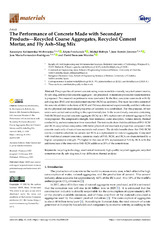The Performance of Concrete Made with Secondary Products—Recycled Coarse Aggregates, Recycled Cement Mortar, and Fly Ash–Slag Mix
Autor
Kalinowska-Wichrowska, Katarzyna
Pawluczuk, Edyta
Bołtryk, Michał
Jiménez, José Ramón
Fernández Rodríguez, José María
Suescum-Morales, David
Editor
MDPIFecha
2022Materia
Recycling technologyMechanical treatment
High quality recycled aggregate
Recycled cement mortar
Fly ash–slag mix
X-ray diffraction
Thermal analysis
METS:
Mostrar el registro METSPREMIS:
Mostrar el registro PREMISMetadatos
Mostrar el registro completo del ítemResumen
The properties of cement concrete using waste materials—namely, recycled cement mortar, fly ash–slag, and recycled concrete aggregate—are presented. A treatment process for waste materials is proposed. Two research experiments were conducted. In the first, concretes were made with fly ash–slag mix (FAS) and recycled cement mortar (RCM) as additions. The most favorable content of the concrete additive in the form of RCM and FAS was determined experimentally, and their influence on the physical and mechanical properties of concrete was established. For this purpose, 10 test series were carried out according to the experimental plan. In the second study, concretes containing FAS–RCM and recycled concrete aggregate (RCA) as a 30% replacement of natural aggregate (NA) were prepared. The compressive strength, frost resistance, water absorption, volume density, thermal conductivity, and microstructure were researched. The test results show that the addition of FAS–RCM and RCA can produce composites with better physical and mechanical properties compared with concrete made only of natural raw materials and cement. The detailed results show that FAS–RCM can be a valuable substitute for cement and RCA as a replacement for natural aggregates. Compared with traditional cement concretes, concretes made of FAS, RCM, and RCA are characterized by a higher compressive strength: 7% higher in the case of 30% replacement of NA by RCA with the additional use of the innovative FAS–RCM additive as 30% of the cement mass.
Fuente
Materials 15(4), 1438 (2022)Versión del Editor
https://doi.org/10.3390/ma15041438Ítems relacionados
Mostrando ítems relacionados por Título, autor o materia.
-
Photocatalytic Recycled Mortars: Circular Economy as a Solution for Decontamination
Barbudo Muñoz, M. Auxiliadora; Lozano Lunar, Angélica; López Uceda, Antonio; Pérez Galvín, Adela; Ayuso Muñoz, Jesús (MDPI, 2020)The circular economy is an economic model of production and consumption that involves reusing, repairing, refurbishing, and recycling materials after their service life. The use of waste as secondary raw materials is one ... -
Effect of the Composition of Mixed Recycled Aggregates on Physical–Mechanical Properties
López Uceda, Antonio; Fernández Ledesma, Enrique; Salas-Morera, Lorenzo; Jiménez, José Ramón; Suescum-Morales, David (MDPI, 2021)Recycled aggregates (RA) from construction and demolition waste are an alternative to natural aggregates in the construction sector. They are usually classified according to their composition. The main constituent materials ... -
Feasible Use of Recycled Concrete Aggregates with Alumina Waste in Road Construction
Cabrera, Manuel; López Alonso, M.; Garach, Laura; Alegre, Javier; Ordóñez, Javier; Agrela Sáinz, Francisco (MDPI, 2021)The management of different industrial by-products, such as recycled aggregates from construction and demolition waste and alumina by-products, as well as the reduction of landfill deposits by incorporating these products ...

